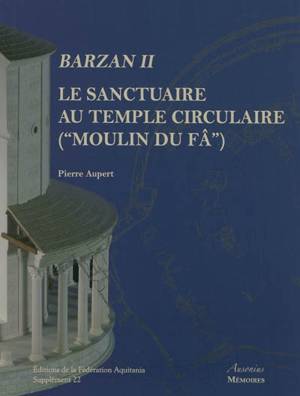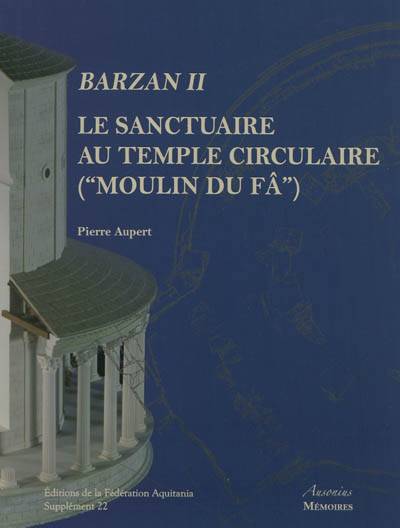
- Afhalen na 1 uur in een winkel met voorraad
- Gratis thuislevering in België vanaf € 30
- Ruim aanbod met 7 miljoen producten
- Afhalen na 1 uur in een winkel met voorraad
- Gratis thuislevering in België vanaf € 30
- Ruim aanbod met 7 miljoen producten
Le sanctuaire au temple circulaire, Moulin-du-Fâ
tradition celtique et influences gréco-romaines
Pierre AupertOmschrijving
Le sanctuaire au temple circulaire (« Moulin du Fâ »)
Tradition celtique et influences gréco-romaines
Le temple du « Moulin du Fâ » figure sur les cartes depuis le début du XVIIIe s. et fait l'objet de fouilles depuis celui du XXe. Grâce aux les photos aériennes de J. Dassié de 1976, on sait qu'il est installé en bordure d'une vaste agglomération. Mais la fouille de P. Aupert, relayé par K. Robin, a provoqué deux surprises : l'occupation du site remonte au moins au Ve s. avant notre ère, ce qui en fait l'un des plus anciens de la région, et le sanctuaire a conservé son aspect celtique, avec sa vaste cour entourée d'un fossé et ses constructions en bois, beaucoup plus longtemps sous l'Empire romain que les autres lieux sacrés d'avant la conquête césarienne. Ce n'est en effet que sous Hadrien, dans les années 130, qu'on le remblaie et que l'on y édifie l'imposant temple à cella et péristyle circulaires que l'on y voit aujourd'hui, très probablement en l'honneur d'un Mars considéré plus comme protecteur de la communauté locale que comme dieu de la guerre romain. Ce conservatisme religieux a laissé des traces dans les rites, avec la poursuite de la tenue de banquets. Il en a laissé surtout dans l'architecture, que quelques éléments nous permettent de reconstituer à quelques détails près : ce sont les fosses qui s'ouvrent dans le sol de la cella et la surélévation de celle-ci par rapport à la colonnade périphérique. En revanche, les architectures grecque et romaine ont inspiré tout le reste : c'est une tholos grecque, avec des colonnes corinthiennes, que l'on a installée sur un podium romain et pourvue d'un porche monumental, comparable à celui du Panthéon de Rome. Une recherche attentive montre aussi que le concepteur de l'ouvrage a été formé aux meilleures écoles, qu'il connaissait la mathématique grecque autant que les audaces des architectes romains. Plus grand que la Tour de Vésone, son parallèle le plus proche, le temple santon de Barzan illustre sans doute la rivalité de la capitale régionale, Saintes, avec la Périgueux des Pétrucores, voire avec Bordeaux. Il témoigne surtout de l'ambition d'un riche notable saintais, soucieux de s'illustrer, comme de justifier et d'affermir sa position dans les hautes sphères politiques de l'Empire.
The temple « Moulin-du-Fâ » has been spotted on the maps since the early 18th century and is being excavated since the early 20th century. Thanks to aerial photographs of J. Dassié in 1975, the temple is known to be located next to a large city. But the excavations of P. Aupert, followed by K. Robin's, have unveiled two surprises : the occupation of the site dates back to the 5th century BCE at least, making it one of the oldest of the region, and the sanctuary has kept its Celtic layout - with its large courtyard surrounded by a moat and wooden buildings - much longer under the Roman Empire than the other sacred places of the pre-caesarean conquest era. In fact, it was under Hadrian, during the 130s, that the site was filled in and the imposing temple with a cella and a circular peristyle was built. The temple was most probably dedicated to Mars, considered more like the protector of the community than like the roman god of war. This religious conservatism has left traces in the rites with the continued holding of banquets. These traces are even more significant in the architecture. A few clues - the pits opened into the floor of the cella and the cella raising above the peripheral colonnade - have led to a detailed reconstruction. On the other hand, Greek and Roman architectures have inspired everything else : this is a Greek Tholos, with Corinthian columns, installed on a Roman podium, and a monumental porch, comparable to the Pantheon of Rome. A careful research has also shown that the designer was highly educated and that he was familiar with Greek mathematics and daring creations of Roman architects. The santon temple of Barzan - which is higher than its closest parallel, the Tower of Vésone - probably illustrates the rivalry of the regional capital, Saintes with Périgueux of the Pétrucores and even with Bordeaux. It also mainly reflects the ambition of a rich notable of Saintes, willing to shine and trying to justify and strengthen its position in the high political spheres of the Empire.
Specificaties
Betrokkenen
- Auteur(s):
- Illustrator(s):
- Uitgeverij:
Inhoud
- Aantal bladzijden:
- 470
- Taal:
- Frans
- Reeks:
Eigenschappen
- Productcode (EAN):
- 9782356130402
- Verschijningsdatum:
- 18/04/2011
- Uitvoering:
- Hardcover
- Afmetingen:
- 230 mm x 290 mm
- Gewicht:
- 2400 g

Alleen bij Standaard Boekhandel
Beoordelingen
We publiceren alleen reviews die voldoen aan de voorwaarden voor reviews. Bekijk onze voorwaarden voor reviews.











